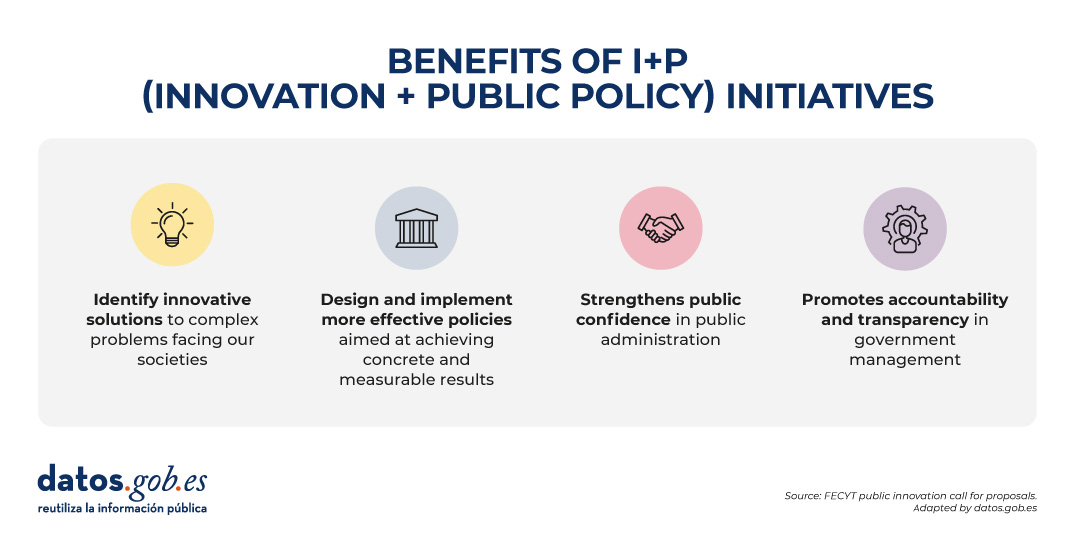
In an increasingly complex world, public decisions need more than intuition: they require scientific evidence. This is where I+P (Innovation + Public Policy) initiatives come into play: an intersection between creativity, data-driven knowledge, and policy action.
In this article we will explain this concept, including examples and information about funding programs.
What is I+P?
I+P is not a mathematical formula, but a strategic practice that combines scientific knowledge, research, and citizen participation to improve the formulation, implementation, and evaluation of public policies. It is not only a matter of applying technology to the public sphere, but of rethinking how decisions are made, how solutions are formulated and how society is involved in these processes through the application of scientific methodologies.
This idea stems from the concept of "science for public policy", also known as "science for policy" or "Science for Policy" (S4P) and implies active collaboration between public administrations and the scientific community.
I+P initiatives promote empirical evidence and experimentation. To this end, they promote the use of data, emerging technologies, pilot tests, agile methodologies and feedback loops that help design more efficient and effective policies, focused on the real needs of citizens. This facilitates real-time decision-making and the possibility of making agile adjustments in situations that require quick responses. In short, it is about providing more creative and accurate responses to today's challenges, such as climate change or digital inequality, areas where traditional policies can fall short.
The following visual summarizes these and other benefits.

Source: FECYT Call for Public Innovation - adapted by datos.gob.es.
Examples of R+P initiatives
The use of data for political decision-making was evident during the COVID-19 pandemic, where policymakers were adapting the measures to be taken based on reports from institutions such as the World Health Organization (WHO). But beyond these types of extraordinary events, today we find consolidated initiatives that increasingly seek to promote innovation and decision-making based on scientific data in the public sphere on an ongoing basis. Let's look at two examples.
-
Periodic reports from scientific institutions to bring scientific knowledge closer to public decision-making
Scientific reports on topics such as climate change, bacterial resistance or food production are examples of how science can guide informed policy decisions.
The Science4Policy initiative of the Spanish National Research Council (CSIC) is an example of this. It is a collection of thematic reports that present solid evidence, generated in its research centers, on relevant social problems. Each report includes:
- An introduction to the problem and its social impact.
- Information on the research carried out by the CSIC on the subject.
- Conclusions and recommendations for public policies.
Its main objective is to transform scientific knowledge into accessible contributions for non-specialized audiences, thus facilitating informed decisions by public authorities.
-
Public innovation laboratories, a space for science-based creativity
Public innovation labs or GovLabs are experimental spaces that allow public employees, scientists, experts in various fields and citizens to co-create policies, prototype solutions and learn iteratively.
An example is the Public Innovation Laboratory (LIP) promoted by the National Institute of Public Administration (INAP), where pilots have been carried out on the use of technologies to promote the new generation of jobs, intermunicipal collaboration to share talent or the decentralization of selective tests. In addition, they have an Innovation Resources Catalogue where tools with open licences launched by various organisations are compiled and can be used to support public entrepreneurs.
It is also worth highlighting the Spanish Network for Public Innovation and Scientific Transfer, promoted by the NovaGob Foundation. It is a collaborative space that brings together professionals, public administrations, universities and third sector organisations with the aim of transforming public management in Spain. Through working groups and repositories of good practices, it promotes the use of artificial intelligence, administrative simplification and the improvement of citizen service.
We also find public innovation laboratories at the regional level, such as Govtechlab Madrid, a project led by the madri+d Foundation for Knowledge that connects startups and digital SMEs with public institutions to solve real challenges. During the 2023/2024 academic year, they launched 9 pilots, for example, to collect and analyse the opinion of citizens to make better decisions in the Alcobendas City Council, unify the collection and management of data in the registrations of the activities of the Youth Area of the Boadilla del Monte City Council or provide truthful and updated information digitally on the commercial fabric of Mostoles.
The role of governments and public institutions
Innovation in public policy can be driven by a diversity of actors: public administrations open to change, universities and research centres, civic startups and technology companies, civil society organisations or committed citizens.
The European Commission, for example, plays a key role in strengthening the science-for-policy ecosystem in Europe, promoting the effective use of scientific knowledge in decision-making at all levels: European, national, regional and local. Through programmes such as Horizon Europe and the European Research Area Policy Agenda 2025-2027, actions are promoted to develop capacities, share good practices and align research with societal needs.
In Spain we also find actions such as the recent call for funding from the Spanish Foundation for Science and Technology (FECYT), the Ministry of Science, Innovation and Universities, and the National Office of Scientific Advice, whose objective is to promote:
- Research projects that generate new scientific evidence applicable to the design of public policies (Category A).
- Scientific advice and knowledge transfer activities between researchers and public officials (Category B).
Projects can receive up to €100,000 (Category A) or €25,000 (Category B), covering up to 90% of the total cost. Research organizations, universities, health entities, technology centers, R+D centers and other actors that promote the transfer of R+D can participate. The deadline to apply for the aid ends on September 17, 2025. For more information, you should visit the rules of the call or attend some training sessions that are being held.
Conclusion
In a world where social, economic and environmental challenges are increasingly complex, we need new ways of thinking and acting from public institutions. For this reason, R+P is not a fad, it is a necessity that allows us to move from "we think it works" to "we know it works", promoting a more adaptive, agile and effective policy.


